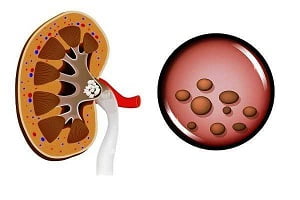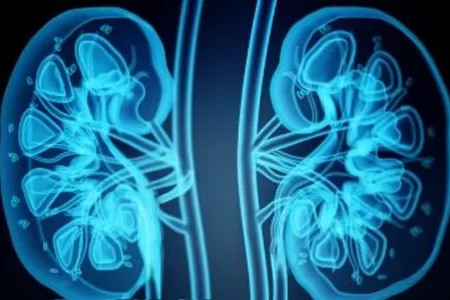How Does the Size of a Kidney Stone Matter?
- Updated on: Nov 16, 2023
- 7 min Read
- Published on Feb 10, 2020

Kidney stones (calculi) are the chemical deposits that form in the kidney. They are the microscopic particles or crystals that can develop into stones over time. The medical term used for this condition is nephrolithiasis.
Kidney stones can be of different sizes. Many of these stones are so small that they are able to travel to the bladder in just a few days or weeks and can easily pass through urine. The stones that are large in size get stuck as they exit the renal pelvis or take longer to move through the ureter, causing severe pain and other symptoms.
Stones in kidneys are formed due to a decrease in urine volume or accumulation of unwanted toxic substances. They are small in beginning but can grow larger. Small stones stay in the kidney and do not cause any problems.
Kidney stones are associated with an increased risk of chronic kidney diseases, end-stage renal failure, cardiovascular diseases, diabetes, and hypertension. Many studies suggest that formation of the kidney stones may be a systemic disorder linked to the metabolic syndrome. Nephrolithiasis is responsible for 2 to 3% of end-stage renal cases if it is associated with nephrocalcinosis.
Pathophysiology of Kidney Stones
The pathophysiology of kidney stones is complex and varies from patient to patient. About 80% of stones contain calcium, generally in the form of calcium phosphate or calcium oxalate. The calcium oxalate stones develop on Randall’s plaques which are composed of calcium phosphate crystals. The majority of the remaining stones are composed of uric acid, cystine, and magnesium ammonium phosphate (struvite) combined with apatite.
The most frequently identified metabolic abnormality found in patients with renal calculi is hypercalciuria, with stones formed by crystallization of a nidus in the presence of supersaturated urine.
Size of Kidney Stones
The kidney stones are of different sizes – from very small to large-sized stones. Stones that are smaller than 4 millimeters (mm) pass on their own in about 30 days on an average. Stones that are 4–6 millimeters (mm) in size require treatment, but most of them also pass naturally in around 45 days.
Stones that are larger than 6 millimeters (mm) are first needed to be removed with the help of medical treatments. Only about 20 percent of them can pass naturally according to reports.
A stone can be classified according to its anatomical position in the urinary collecting system at diagnosis: upper calyx, middle calyx or lower calyx, renal pelvis, upper ureter, middle ureter or distal ureter, and urinary bladder.
Lithotripsy is a procedure which is used for kidney stones that do not pass on their own. The shock waves are used to break up a large stone into smaller pieces that can then pass through the urinary system.
Determining Kidney Stone Sizes Through Tests
Kidney stones are generally diagnosed by a doctor based upon your symptoms, a physical examination, and imaging tests. These tests help your doctor know the exact size, locations, and numbers of such stones you may have. The two most common tests for determining stones size and location are:
Computed tomography (CT) scan — A CT scan is used to create three-dimensional images of structures within the body. Non-contrast CT scans are often recommended if kidney stones are suspected because they provide best visualization. X-rays are not reliable to determine necessary stone characteristics all the time.
Ultrasound — An ultrasound (or sonogram or USG) is commonly used to detect kidney stones, their sizes and locations. Small sized stones or stones in the ureters (the tubes that connect your kidneys to the bladder) may not be detected through ultrasound though. Still, ultrasound is the preferred diagnostic procedure for several reasons such as safety, costs etc.
Ultrasonic Determination of Kidney Stone Size
According to a systemic review published in ‘Research and Reports in Urology’ in 2018, the sensitivity and specificity for renal calculi are 45% and 88%, respectively, and for ureteric calculi, they are 45% and 94%, respectively. The sensitivity of ultrasound (USG) decreased when the size of the stone is <3 mm, and the sensitivity increased as the size of the stone increased.
The only limitation with a USG is its reduced sensitivity and specificity when compared with CT for diagnosing smaller stones of the kidneys. However, ultrasounds are usually preferred by doctors as first line diagnostic methods for determining kidney stones as USGs are easy to perform and involve less costs. They are much safer as well on particularly pregnant women. Therefore, supporting an “ultrasound-first” approach to determining renal colic in the emergency departments (ED) remains important for improving patient care and decreasing healthcare costs even though CT scans are more sensitive in determining small-sized stones.
Do Larger Stones Cause More Pain?
Kidney stone pain is one of the most severe types of pain. The pain can be compared with childbirth pain or pain getting stabbed with a knife. Kidney stone pain usually starts suddenly and radiate in belly and groin areas as the stone moves down into the narrow ureter. This causes a blockage because of which pressure builds up in the kidney. As the stone moves, the pain changes its location and intensity.
Pain often starts and goes in waves, which is made worse by the ureters contracting as they try to push the stone out. The wave lasts for few minutes, disappear, and then come back again.
The stones large in size are more painful than smaller ones, but the severity of pain doesn’t relate to the size of the stone alone. Sometimes, even little stones can be quite painful when they move or cause a blockage in ureters.
According to Michael Borofsky, M.D, University of ChicagoPain, the hallmark symptom of stone disease, accounts for over one million emergency room visits by such patients in the United States each year.
Can Large Stones be Passed Naturally?
Many people are worried when they get their ultrasound or CT scan report particularly if the size of the stone is large. Large stones not only can cause more severe pain but may be difficult to pass naturally without any interventional methods. It’s a common concern in such patients as to whether their stones require a surgery. Some people fear surgical interventions and want to try out natural ways of passing stones. Learn about the passing of stones naturally with urine.
Doctors believe that large stones rarely pass on their own. At the same time, removing them is more important as they can damage your kidneys over time. They can grow even larger and cause more complications. Read about complications of kidney stones.
In order to remove them, your doctor will do a procedure to first break up the stone into smaller particles. The procedure is known as lithotripsy. These smaller pieces can then pass on their own or may be removed with a surgery.
Is Lithotripsy a Safe Procedure for Breaking Large-Sized Kidney Stones?
Lithotripsy is a fairly safe and quick procedure that uses shock waves to break up the stones in your kidney, bladder, or ureter. Extracorporeal shock wave lithotripsy (ESWL) is the most common type of all forms of lithotripsy.
Your doctor will give you medicine for pain relief or to help you relax before the procedure begins. When you are ready for the procedure, you may be given general anesthesia so you fall asleep and pain-free. High-energy shock waves, also called sound waves will pass through your and hit the stones to break them into pieces. If you are awake, you may feel a slight tapping feeling when this occurs.
The lithotripsy procedure finishes in about 1 hour. A tube may be placed to drain urine from the kidneys until all the small pieces of stone pass out of your body.
The recovery time is generally brief. After the treatment, the patient can get up to walk almost immediately. Many people fully resume daily activities within two to three days.
Tips to Treat and Prevent Kidney Stones
- Drink at least 8-12 glass of water or fluid each day
- Consume large amount of dairy foods every day
- Consume less amount of sodium
- Limit excessive intake of vitamin-C rich supplements
- Limit foods high in oxalate.
- Maintain Healthy Body Weight
Dr. Ralph Clayman, UCI Health urologist and a pioneer in minimally invasive treatment of kidney diseasesays “If everybody drank three quarts of water a day, I’d have to retire because I’d have nothing to do. It’s truly a problem due to too little fluid intake.”
Interventions for Preventing Kidney Stone Recurrence
Dietary interventions help prevent stone recurrence by altering concentrations of crystal-forming or crystal-inhibiting substances in urine. Certain dietary recommendation are:
- Increasing water intake
- Reducing dietary oxalate
- Reducing dietary animal protein and other purines
- Maintaining normal dietary calcium
Pharmacological interventions may also be suggested to prevent stone recurrence in high risk patients, such as use of:
- Thiazide diuretics
- Citrate
- Indapamide
- Allopurinol
- Magnesium hydroxide
- Acetohydroxamic acid
FAQs
What Size of Kidney Stone is Dangerous?
Kidney stones larger than 5 mm cannot pass on their own and are considered dangerous. These kidney stones not only cause pain, they can also damage kidneys by blocking the flow of urine and causing bleeding and infection. The large-sized stones may obstruct the kidneys, which may cause the urine to become so infected that the bacteria gets into the blood stream and gets all over the body. This is called sepsis. This type of condition requires immediate medical intervention for removal.
Can a Kidney Stone Grow in Size?
Kidney stones start small in size in the beginning but can grow larger in size over time. As they grow in size, they can fill the inner hollow structures of your kidneys if they are not removed. This may lead to severe infections and other complications. It is recommended to contact your doctor if you feel you may have a stone in the kidney or if you are at high risk of them so they can be prevented or removed in early stages when they are small.
What Size of Kidney Stone is Considered Large?
Large kidney stones are stones that measure approximately 5 mm or larger. Based on their size, they may get struck in the urinary tract and cause extreme pain and bleeding during urination. Larger stones become lodged in the urinary tract, and are associated with a urinary tract infection and other symptoms. Large kidney stones require medical intervention for removal, shock Wave Lithotripsy (SWL) is a procedure used by doctors to treat stones in the kidney and ureter that are large in size. The procedure involves breaking the bigger stones into smaller crystals which can then easily pass through urine.
What Size Kidney Stones Require Surgery?
Kidney stones 5 mm or larger in size cannot pass on their own and require surgery for removal. There are several methods for breaking down or removing large kidney stones.
- Shock wave lithotripsy (ESWL): The procedure requires either light sedation or anesthesia and usually lasts between 45 minutes and an hour. The procedure involves breaking the bigger stones into smaller crystals which can then easily pass through urine.
- Ureteroscopy: In this procedure, a surgeon will insert a ureteroscope through the urethra and bladder to the ureters. The ureteroscope is a thin, lighted, tube-like instrument with an eyepiece that allows a urologist to see the kidney stone.
- Surgical removal: Depending on the size of kidney stone, a doctor may choose to perform a Percutaneous Nephrolithotomy (PCNL). This procedure requires general anesthesia, and also requires an overnight stay in the hospital.
Why Do People Get Kidney Stones?
People get kidney Stones because of the following reasons:
- If they have had kidney stones before
- If someone in their family has had kidney stones
- When they don’t drink enough water
- When they follow a diet that's high in protein, sodium (salt) and sugar that may increase their risk of some types of kidney stones.
- If they have had gastric bypass surgery or another intestinal surgery
- Due to other medical conditions that may increase the risk of kidney stones which include Crohn's disease, urinary tract infections, renal tubular acidosis, cystinuria, hyperparathyroidism
- An excessively acidic environment in urine can lead to the formation of kidney stones
- Due to certain medicines, such as diuretics or calcium-based antacids
When there is not enough water to dilute the uric acid, the urine becomes more acidic which leads to kidney stones












